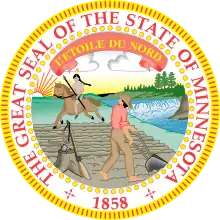Seal of Minnesota
The Great Seal of the State of Minnesota is the state seal of the U.S. state of Minnesota. Originally adopted in 1858, it has undergone several alterations since then, in 1971 and 1983.[2] As depicted on the Flag of Minnesota, the seal has been criticized as racist and white supremacist, depicting a white settler displacing a Native American without historical context provided about violence against Native peoples. As of March 24th, 2022, a new task force has been created by the Minnesota Legislature to discuss possibilities for seal and flag replacement. [3]
| Great Seal of the State of Minnesota | |
|---|---|
 | |
| Versions | |
.jpg.webp) Historical coat of arms (illustrated, 1876) | |
| Armiger | State of Minnesota |
| Adopted | May 10, 1983[1] |
| Motto | L'Étoile du Nord (English: The Star of the North) |
| Earlier version(s) | .svg.png.webp) |
| Use | Former Minnesotan state seal, used from unknown to 1971. |
Symbolism
A Native American rides on horseback in the background, symbolizing Minnesota's Native American heritage. A sun on the western horizon is a sunset. The straight horizon line reflects the plains covering much of Minnesota. The Native American is on horseback is riding towards the south. The native's horse and spear and the pioneer's ax, rifle, and plow represent tools of daily life. The only interaction between the figures is one observing the other. The tools used by the Native American and the farmer represent the tools used for labor and hunting while the stump symbolizes the taming of the land and the importance of the lumber industry to Minnesota in 1858. The Mississippi River and St. Anthony Falls are depicted in the revised seal to note the importance of these resources in transportation, industry and the settling of the state. The furrowing of the ground by the plow represents the submission of the land to the pioneer. The plow also symbolizes the importance of agriculture to Minnesota and its future. The waterfalls are not on the original State Seal. Beyond the falls on the current seal are three pine trees representing the state tree and the three pine regions of the state; the St Croix, Mississippi, and Lake Superior.[4][5][6]
Criticism of Symbolism
As displayed on the Flag of Minnesota, the Minnesota Great Seal has been criticized as racist, said to depict a white settler displacing the original Native American inhabitants of Minnesota. The inferred symbolism has been described as an example of an erasure of Native history to promote white racial power, as the inferred symbolism provides a false historical context for Native genocide and displacement. Discussion is ongoing about the historical context of the seal, particularly the absence of Native American voices in the creation of a seal that represents their native homeland. [7]
Government Seals of Minnesota
 Seal of the Minnesota Department of Transportation
Seal of the Minnesota Department of Transportation Seal of the Minnesota National Guard
Seal of the Minnesota National Guard
See also
References
- Office of the Revisor of Statutes (May 10, 1983). "119". 1.135 STATE SEAL. Laws of Minnesota. State of Minnesota. Archived from the original on March 12, 2014. Retrieved March 12, 2014.
- Minnesota Historical Society. "State Seal" (PDF). State of Minnesota. pp. 21–23. Archived from the original (PDF) on September 5, 2005. Retrieved September 5, 2005.
- Harrington, Judith (2015). "...what about Minnesota's?". startribune.com.Grindy, Mark (2020). "Racist state flags need to go". startribune.com. "HF284". 2021.
- "Minnesota Statutes - 1.135 STATE SEAL". Office of the Revisor of Statutes. 1983. Archived from the original on June 9, 2012. Retrieved June 9, 2012.
- www.n-state.com, NSTATE, LLC. "Minnesota State Flag - About the Minnesota Flag, its adoption and history from NETSTATE.COM". www.netstate.com. Retrieved 2017-08-11.
- "1.135, 2011 Minnesota Statutes". 2012-06-09. Archived from the original on 2012-06-09. Retrieved 2017-08-11.
- Harrington, Judith (2015). "...what about Minnesota's?". startribune.com.Grindy, Mark (2020). "Racist state flags need to go". startribune.com.
.svg.png.webp)